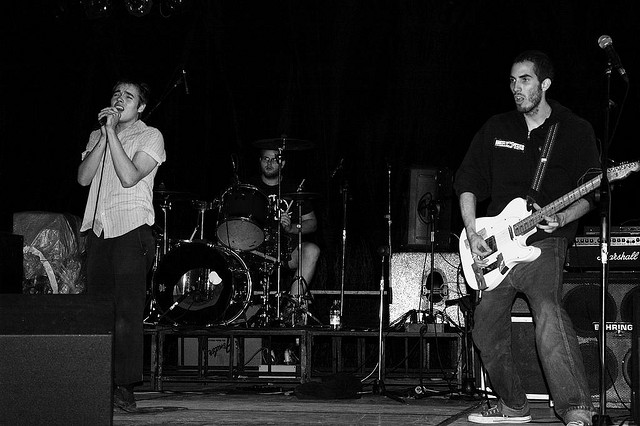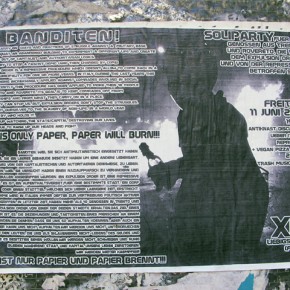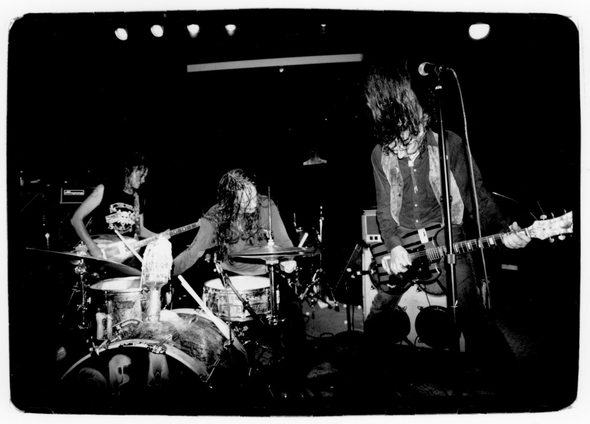The previous decade – let’s call them the noughties – showed the punk scene regrouping after the 1990s. Amid the flood of great new music, many full-lengths were inevitably overlooked or were lost in the chaos. Other releases got momentary attention, but were quickly forgotten. Here are some of the best LPs from the previous decade that are worth revisiting.
1.) LOST SOUNDS: Black Wave (2001)
Memphis, Tennessee’s Lost Sounds was an ambitious project headed up by the twin geniuses of Alicja Trout and Jay Reatard. Nowadays, there is a coldwave revival, and the term “darkwave” has also come into vogue to describe a universe of dark, postpunky sounds from gothic rock to minimal. I’ve even seen the term “chillwave” bandied about. The uber-hip Mishka NYC blog tried to coin the term “grave wave” a couple years back.
Perhaps anticipating this trend, Lost Sounds called their second full-length LP Black Wave in 2001. The band’s first LP, 1999’s Memphis is Dead, showcased a novel and compelling attempt at synthesizing US garage punk, Scandinavian black metal, and California deathrock. By the time Black Wave came out, a lot of the black metal influences had been discarded in favor of lo-fi new wave and other types of postpunk. The result is a swirling, herky-jerky, angular, analog synth-driven masterpiece of Devo-esque hooks and brash punk attitude. Throw in some Screamers influences and you get a great sophomore LP. Of course, Jay Reatard would die of a cocaine and alcohol overdose age 29, in 2010.
The recent Lost Lost Lost Sounds demos release has prompted a reevaluation of Lost Sounds’ legacy.
http://youtu.be/_Xn5796w8z4
2.) UNDER PRESSURE: Come Clean (2006)
This Canadian hardcore unit was always a favorite of mine. Whereas most punk bands start out good and get progressively suckier with each new release, Under Pressure defied this trend, started out good, and got progressively great. Although Fucked Up were Canada’s most visible, breakthrough hardcore act of the past decade, Under Pressure unpretentiously slogged away in the snows of Winnipeg, a sleeper punk band that never got the exposure or fame they deserved. Under Pressure’s first LP, 2003’s Still No Future, is a thrashy slab of fastcore that belongs on the shelf next to bands like DS-13 and Scholastic Deth. Energetic and fine for what it is, but a little undisciplined.
By Come Clean in 2006, however, the band’s attack had been honed to devastating and marvelous effect. The guiding ideal seemed to be Poison Idea’s landmark Feel the Darkness LP. Elements of Damaged-era Black Flag and DC hardcore band Swiz can also be heard in the mix (The Under Pressure track Suspension is, in fact, the best song Swiz never wrote.) And as with those American bands, Under Pressure’s lyrics always tended towards the personal as opposed to the globally political. Under Pressure, though Canadian, often sounded much more like a classic American hardcore band than did many US bands of the past decade.
Featuring unusually thoughtful songwriting and confident, masterful musicianship, Come Clean is one of the great overlooked hardcore punk LPs of the past decade.
http://youtu.be/KR5_LK6YdSs
3.) THE OBSERVERS: So What’s Left Now? (2005)
Many people still remember The Observers’ one and only LP, but it is still worth pointing out again how remarkable and fresh-sounding it was at the time, especially in the milieu from which it arose. In retrospect, 2005’s So What’s Left Now? inaugurated a kind of sea change in the underground, DIY hardcore scene that helped usher in or at least make some cultural space for a new wave of bands like Arctic Flowers, The Estranged, Sick Secrets, Bloody Gears, and many more darker, more postpunk-influenced punk bands.
Reviews at the time compared the Portland band to everyone from Warsaw to the Dead Kennedys (!). The band reminded scores of d-beat fans that there was in fact a darker, more nuanced, and vulnerable side of the punk musical spectrum that warranted further exploration. “So What’s Left Now?” was a jarring LP that seemed to say, “Don’t you remember that punk can also be like this?” In the Observers’ sound there are elements of bands like The Mob, Under Two Flags (see their song “Drown Inside,) Famous Imposters, and the Observers’ kindred Pacific Northwest spirits in The Wipers. The unique band combined a kind of crooning, postpunk vocal style with an at-times jangly guitar sound. “So What’s Left Now?” was the kind of LP that reminded folks of some other band – some other band that could never quite be placed. In fact, a lot of great music has that quality – you feel instantly familiar with it, like the songs have been waiting for you to discover them. That’s the effect The Observers’ music still has.
The Observers still soldier on as the Red Dons, and continue to release great material.
4.) KILLING JOKE: Hosannas from the Basements of Hell (2006)
I had heard Killing Joke plenty of times before the 2006 Hosannas from the Basements of Hell LP, but for some reason the band never clicked for me. Despite my best and most open-minded attempts at giving the group a fair listen, the light switch just never went on. I resigned myself to seeing the band the way some folks talk about King Crimson – an obviously important and innovative entity, apparently, and respected by many other bands I liked, but nothing really jumped out and grabbed me (the way, say, the first Minor Threat 7” did a long time ago.) Amebix, who I had liked for a long time, always talked up the seminal role Killing Joke’s influence had had on their own sound – but, save for a few songs like “The Wait,” I could never really hear much of it.
In 2006, US music mega-retailer Tower Records was in the process of going bust, and I managed to grab Hosannas from the Basements of Hell on blue double 12” vinyl on clearance. The LP’s impressive full-color gatefold art by Russian surrealist Victor Safonkin was a seamless complement to the sonic tumult of the album’s music. The relentless sludginess of the opening track, “This Tribal Antidote,” did indeed recall a slogging Amebix track for me, and slowly I realized what all the other punk bands had been talking about all along. The light switch was finally flipped. The LP’s title song reminds me a little bit of Venom’s “Sons of Satan” but with a gloomy chorus that sounds like it could have been lifted from a Mob song. And “Implosion” was a driving, Motorhead-y slab of caustic thrash. Other songs veered into a kind of dark industrial territory. The whole LP changed how I viewed Killing Joke, and it set off a frenzy of collecting and listening that continues to this day. I worked my way backwards through their catalog with a new understanding of – a new gateway to comprehending — their music.
Killing Joke recorded Hosannas in a basement studio (fittingly named Faust Studios) in Prague, using only 1970s analog equipment. Singer Jaz Coleman was at his booziest and at his most unhealthy, heaviest weight during this time. In the deep-throated, guttural roaring in his voice on this album, you can hear it. Nearly all Killing Joke LPs are about the end of the world, but the apocalyptic feeling on Hosannas was viscerally tangible. Diehard Killing Joke fans are split on the appeal of the LP; those for whom 1986’s Brighter Than a Thousand Suns was the high mark of the band’s career seem to find Hosannas a little too rough and alienating. The LP is, in fact, more in the aural ballpark of crusty bands like Tragedy or Born Dead Icons than, say, postpunk of The Mission UK or New Model Army variety.
Unfortunately, only the Japanese version of the LP contains the epic masterpiece that is “Universe B,” a brooding and Lovecraftian slog of downtuned crust that is one of my favorite Killing Joke songs of all time. Since Hosannas, the band has released two other fine LPs. But Hosannas from the Basements of Hell, like The Observers’ So What’s Left Now? LP, lifted me out of a d-beat slump and opened my eyes to other possible sounds.
5.) THE DAILY VOID: Identification Code: 5271-4984953784-06564 (2007)
Last decade’s Chicago garage punk scene – by which I mean bands like the Tyrades and the Busy Signals – was a dependably great source of music. The 2001-2006 Blackout fests were proof of this. Included among Chicago’s finest were the Functional Blackouts, ¾ of whom went into the genuinely weird, paranoiac punk band Daily Void, a band who (either coincidentally or not) sounded like a weird combination of Rudimentary Peni, Flipper, and the UFO-obsessed Darvocets.
I remember finding Daily Void on MySpace in 2006, where I noticed that the band’s “Top Friends” (remember that feature on that old site?) were Satan, The Moon, and Santa Claus, not necessarily in that order. The meticulous and surrealist collage art of singer Christopher Ilth seemed a perfect addition to the music, most of which involves themes of depersonalization in mass society, paranoia, dehumanization, and a creepy, Twilight Zone-esque sense of being alone in a society teeming with strange, robotic aliens – i.e., other humans.
Daily Void’s lone LP (which I refer to simply as “Identification Code,” minus the string of numbers in the title) is the kind of off-kilter, art-damaged, bizarro, ranting type of punk I first found and loved in bands like The Screamers, Stickmen with Ray Guns, and Nervous Gender. Or, at least, Daily Void has always seemed happily at home in their company in my imagination. For some reason, I like to think that if Rod Serling had had a favorite punk band, it would have been these guys. And, hilariously, Mishka NYC called them a “grave wave” band.
Unfortunately, there isn’t much Daily Void stuff on Youtube, including a lot of my favorite tracks off their LP. I remember feeling like Identification Code was unfairly passed over in 2007. I’m still not sure why. It’s a great LP – one of my favorites from the last decade – and is yet to receive its proper due.
Observers photo courtesy of Tommy Ironic. Published under a Creative Commons license.






Great write-up. How did I not know about Under Pressure? That song is fantastic.